Step into Hoi An, and you’re immediately transported to a realm of ancient charm and vibrant color. The narrow streets, adorned with glowing lanterns by night, buzz not with traffic but with the murmur of conversation and the distant strains of music. It’s a place that demands a slower pace, inviting you to linger and absorb its unique atmosphere. But beyond the captivating scenery and rich history, Hoi An offers a sensory journey like no other, particularly through its incredible food. For anyone seeking an authentic taste of Central Vietnam, exploring the diverse and unique Hoi An Food Specialties is an absolute must. These dishes are not just meals; they are woven into the fabric of the city’s cultural identity.
Hoi An’s culinary landscape is a reflection of its history as a bustling trading port, blending local traditions with influences from Chinese, Japanese, and European merchants. This fusion has resulted in a collection of dishes found nowhere else, each telling a story of the city’s past and its connection to the land and water. From signature sauces that elevate simple ingredients to complex noodle soups steeped in local legend, the food here offers a deep dive into the soul of Hoi An. It’s a place where street food stalls sit alongside acclaimed restaurants, offering incredible flavors at every turn.
Why Hoi An’s Cuisine Stands Apart
What makes Hoi An Food Specialties so unique? Part of the magic lies in the ingredients and techniques passed down through generations. Many local dishes are said to rely on the specific properties of water drawn from ancient wells within the city, believed to give certain noodles and doughs a distinct texture. This connection to the local environment is crucial. Furthermore, the emphasis on fresh, local produce and seafood, combined with a balance of savory, sweet, sour, and spicy flavors, creates a harmonious and unforgettable culinary experience. It’s this blend of tradition, local resources, and historical influence that elevates Hoi An’s food beyond typical Vietnamese cuisine.
Essential Hoi An Food Specialties You Must Try
Embarking on a culinary tour of Hoi An means ticking off a list of iconic dishes that define the city’s gastronomic identity. Each offers a unique taste and a glimpse into local life and history. These are the key Hoi An Food Specialties that should be on every visitor’s radar.
Hoi An Tuong At: The Signature Chili Sauce
Before diving into specific dishes, it’s worth highlighting an essential condiment that graces almost every table: Tuong At. While many Vietnamese regions have their own chili sauces, Hoi An’s version is truly special. This vibrant garlic chili sauce often incorporates ground sesame and peanuts, adding a nutty depth and creamy texture that complements the fiery heat of locally harvested chilis. It’s more than just a hot sauce; it’s a flavor enhancer that brings out the best in noodles, banh mi, and much more, embodying the unique taste profile of the region.
Banh Mi: Hoi An’s Take on a Vietnamese Icon
You can find Banh Mi across Vietnam, but ask any connoisseur, and they’ll likely point to Hoi An as home to the absolute best. The secret is often attributed to the baguette itself – crisp on the outside, fluffy within, a result of the local water and generations of baking expertise. However, the quality of the fillings and signature sauces truly sets Hoi An Banh Mi apart. It’s rare to encounter a disappointing sandwich here, but two names consistently rise to the top, becoming Hoi An Food Specialties in their own right.
Banh My Phuong: The World-Famous Sandwich
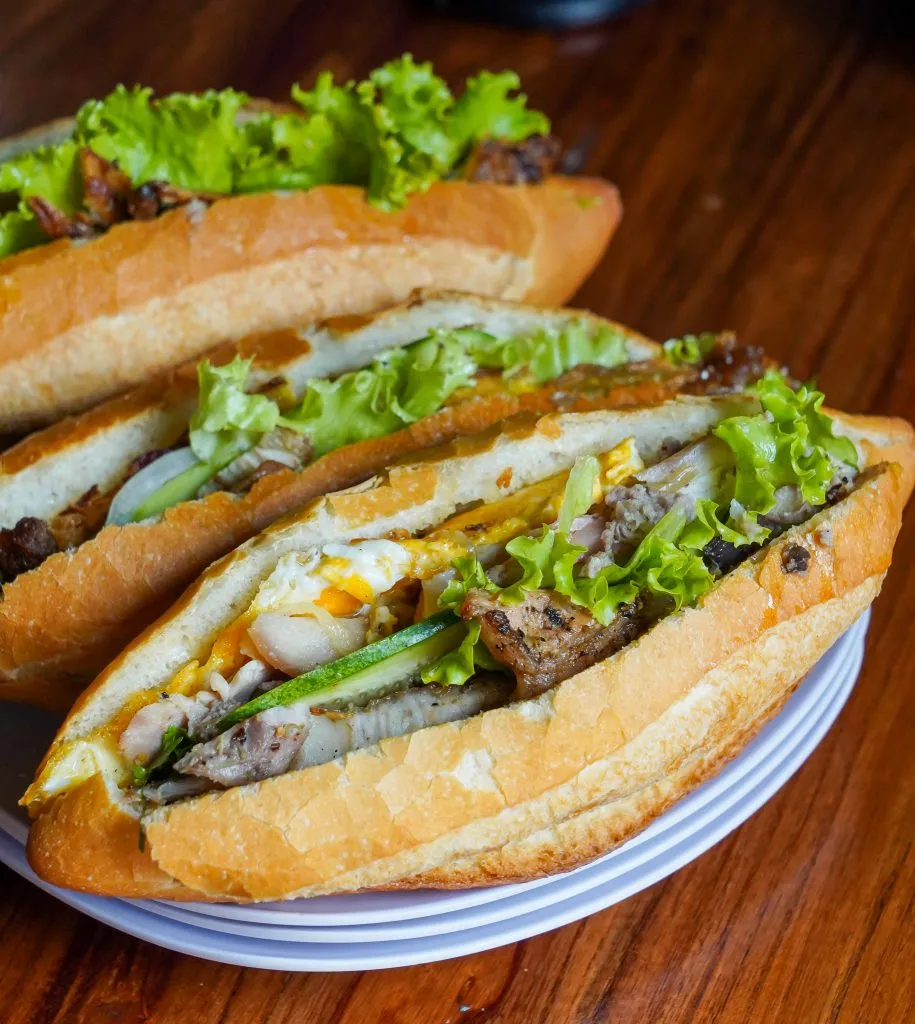 Woman preparing banh mi sandwiches at a busy street stall
Woman preparing banh mi sandwiches at a busy street stall
What to Eat in Fort Worth – A Culinary Deep Dive
Discover the Top Restaurants in Denver – A Culinary Journey
Discover Where to Visit in Las Vegas
Propelled into international fame by Anthony Bourdain, Banh My Phuong is a pilgrimage site for banh mi lovers. Despite the queues, the operation is remarkably efficient, churning out thousands of sandwiches daily. The key here is their generous application of a secret meat sauce and a variety of custom pork fillings, including delicious pâté and ham. While sometimes less spicy than requested, the availability of their excellent Tuong At sauce allows you to customize the heat. It’s undeniably a fantastic sandwich, representing the high standard of Hoi An Food Specialties.
Madam Khanh The Banh My Queen: A Local Favorite
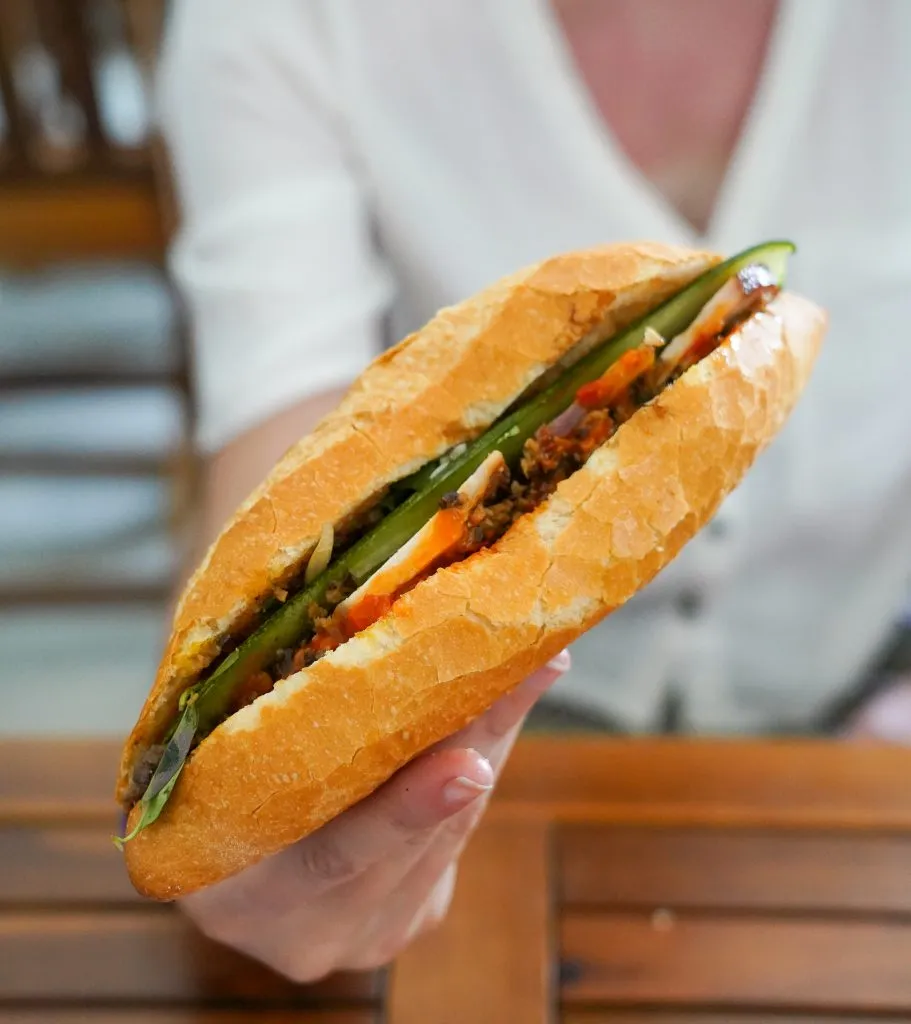 Woman adding ingredients to a banh mi behind a counter
Woman adding ingredients to a banh mi behind a counter
Often cited by locals and many foreign visitors as the true champion, Madam Khanh lives up to her moniker, “The Banh My Queen.” Her ingredients – from the bread and meats to the special sauce – are argued to be a cut above. The result is a sandwich so compellingly delicious that many find themselves ordering a second, especially given the incredibly low price point. While service might be famously no-nonsense, the quality of the Banh Mi speaks for itself, cementing its place among the top Hoi An Food Specialties. Deciding between the two is a delicious challenge best undertaken through direct comparison.
Cao Lau: A Noodle Dish Rooted in Legend
Cao Lau is perhaps the most emblematic of Hoi An Food Specialties, a dish so intrinsically linked to the city that you’ll rarely find an authentic version elsewhere. The name, meaning “high floor,” hints at its origins as a dish initially reserved for the upper class, consumed on upper levels. Its defining features are thick, chewy noodles, slices of succulent pork, fresh herbs, bean sprouts, crispy pork cracklings, and a rich, savory broth (more of a sauce/dressing than a soup).
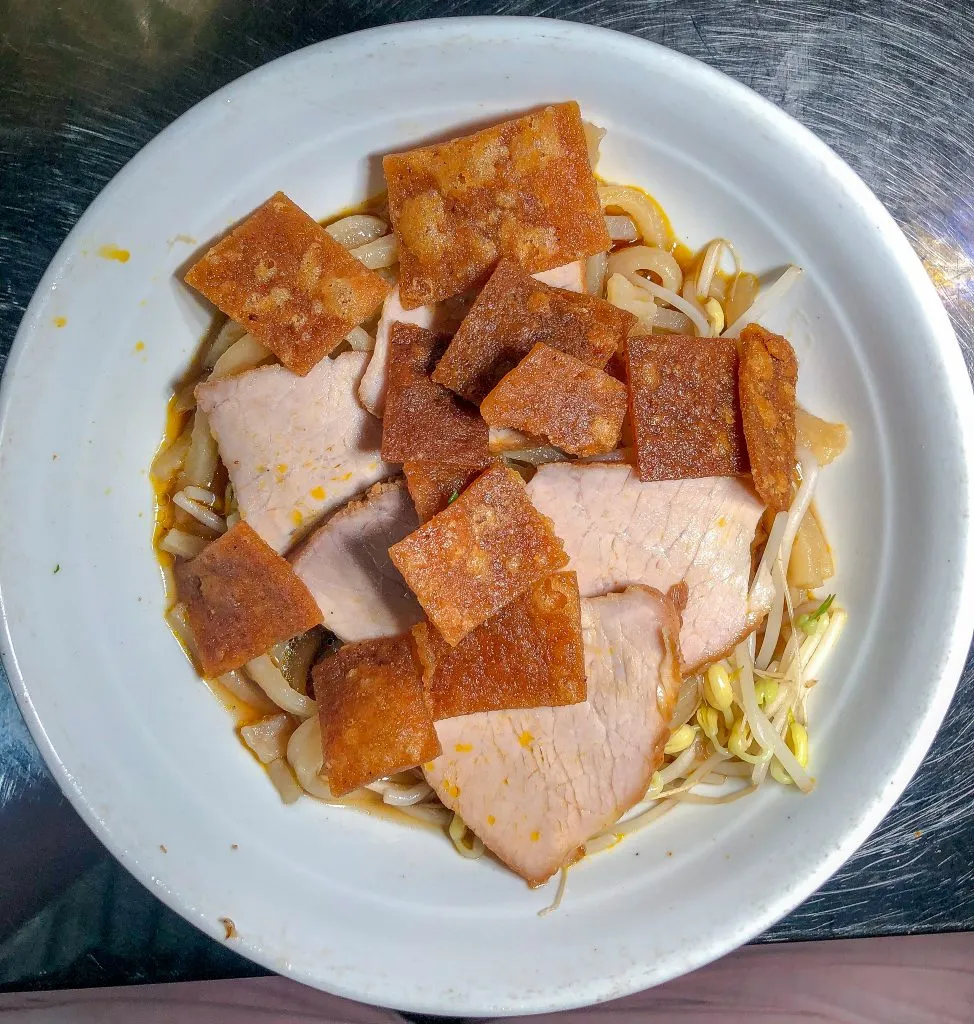 Bowl of Cao Lau noodles with pork, herbs, and crispy bits
Bowl of Cao Lau noodles with pork, herbs, and crispy bits
The unique texture of the noodles is key; they are traditionally made with rice flour and steeped in lye water drawn exclusively from specific ancient wells in Hoi An. This special water is said to give them their signature springiness and chewiness. Finding a favorite Cao Lau spot is a personal quest, with many small eateries and market stalls offering their take. Trying this historically significant and uniquely textured noodle dish is absolutely essential when exploring Hoi An Food Specialties.
Banh Canh: Thick Noodles with a Unique Texture
Another noodle soup that stands out among Hoi An Food Specialties is Banh Canh. What distinguishes this dish is its unique noodles, typically made from tapioca flour or a blend of rice and tapioca, resulting in a thicker, more slippery, and wonderfully chewy texture compared to standard rice noodles. The broth varies by region, but in Hoi An, it often features pork and sometimes fish cakes.
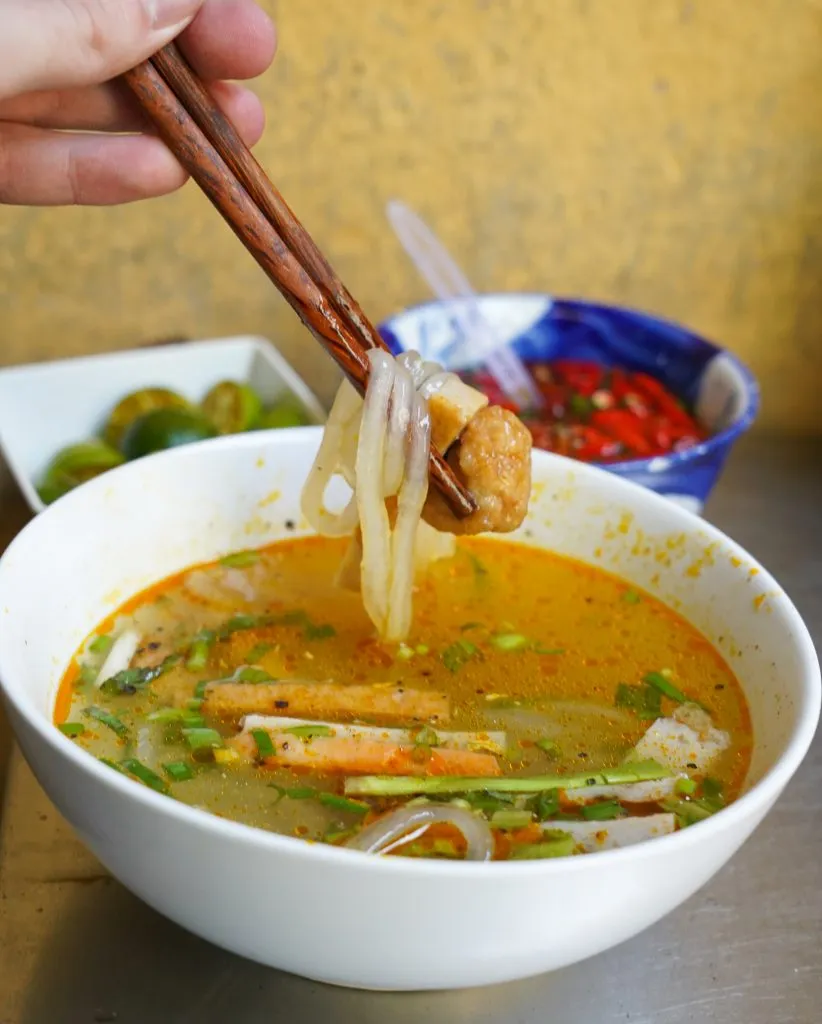 Bowl of Banh Canh noodles with various pork cuts and broth
Bowl of Banh Canh noodles with various pork cuts and broth
Enjoying Banh Canh often involves customizing the flavor with the array of condiments available, particularly chili paste and fish sauce, bringing the broth to life. The rich, slightly viscous broth combined with the substantial noodles makes for a comforting and satisfying meal. Finding a simple, local spot like Ba Quyt offers an authentic experience, where the quality of the ingredients and the customizable sauces truly shine.
White Rose Dumplings (Banh Bao Vac): Elegant and Enigmatic
Visually stunning and delicately flavored, White Rose dumplings are a Hoi An specialty not to be missed. Their name comes from their appearance – translucent white dough pleated and pinched to resemble delicate white roses. The dough, like Cao Lau noodles, is traditionally made using the unique well water of Hoi An, contributing to its thin, slightly chewy texture.
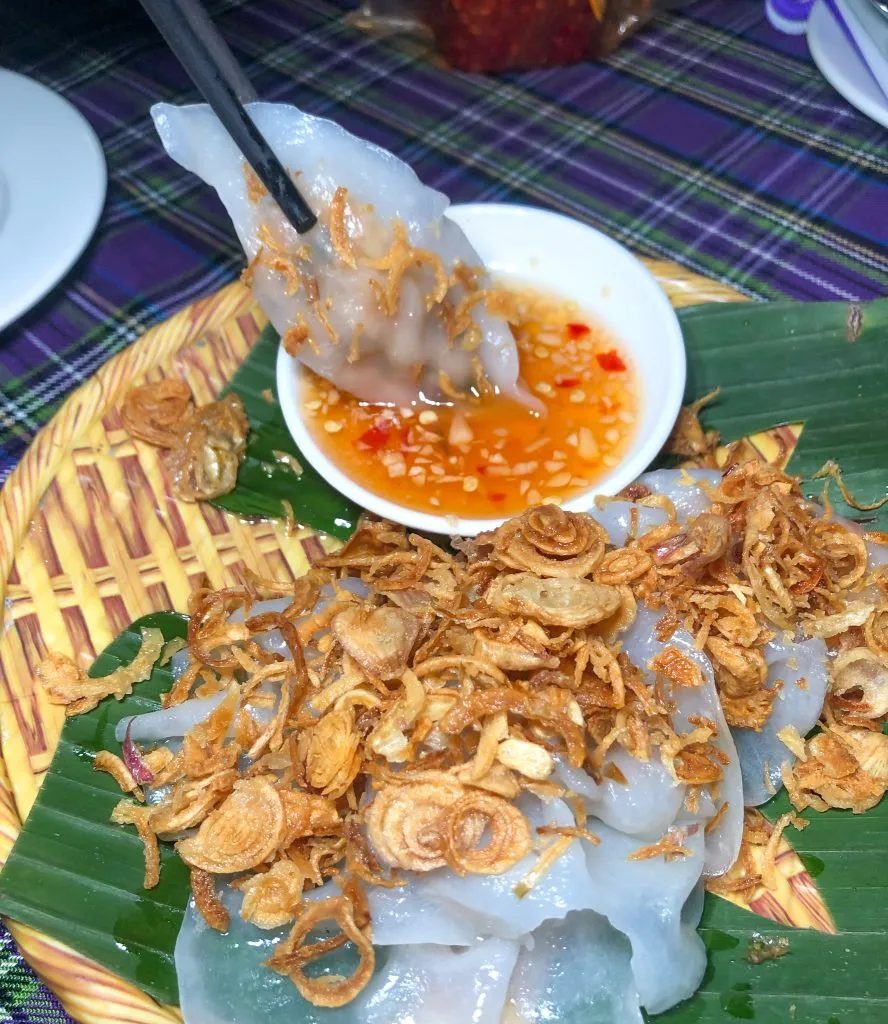 Close-up of White Rose dumplings garnished with crispy shallots
Close-up of White Rose dumplings garnished with crispy shallots
These dumplings are typically filled with either seasoned minced pork or shrimp. They are steamed and served simply, often topped with crispy fried shallots and accompanied by a light dipping sauce made from fish sauce, sugar, lime, and chili. While they might appear subtle in flavor initially, the delicate texture and the interplay with the crispy shallots and tangy dipping sauce reveal why they are considered one of the must-try Hoi An Food Specialties. The White Rose restaurant itself is famous for making and serving these dumplings exclusively.
Mi Quang: Central Vietnam’s Celebration Dish
While found throughout Central Vietnam, Mi Quang is a deeply cherished dish and a significant part of the region’s culinary heritage, often served during family gatherings and celebrations. It’s characterized by wide, flat rice noodles flavored with turmeric, giving them a distinct yellow hue. The broth is rich and flavorful, often simmered with pork or chicken bones, and is served just barely covering the noodles, not as a full soup.
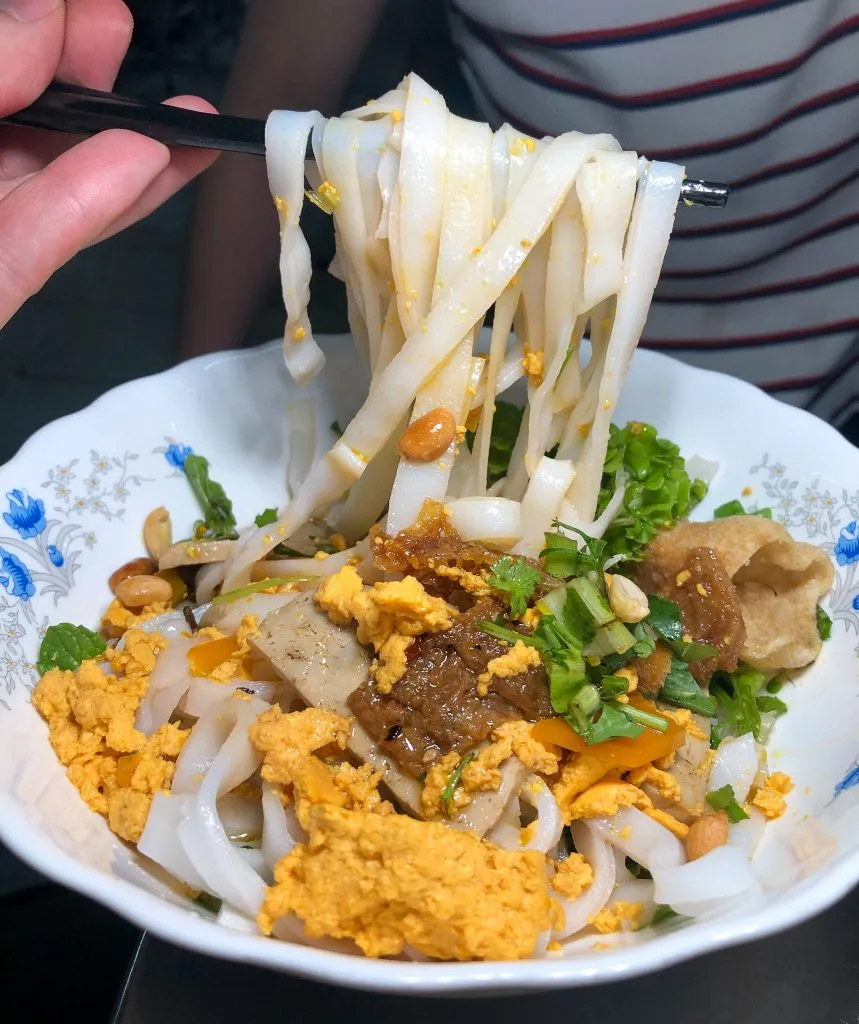 Bowl of Mi Quang noodles with shrimp, pork, herbs, and a small amount of broth
Bowl of Mi Quang noodles with shrimp, pork, herbs, and a small amount of broth
Mi Quang is typically served with a variety of toppings, including slices of pork, shrimp, boiled quail eggs, roasted peanuts, fresh herbs, and crispy rice crackers (banh trang). Breaking the cracker into the bowl adds a delightful crunch and absorbs the flavorful liquid. While seeking out renowned spots like Ong Hai (Mr. Hai) is recommended, exploring local markets often yields hidden gems for this essential Central Vietnamese dish, a cornerstone of Hoi An Food Specialties.
Bale Well: A Feast of Flavors and Textures
Bale Well offers a unique dining experience focused on variety and interaction. While not strictly street food, this open-air local spot presents a fixed, abundant platter showcasing several core Hoi An Food Specialties and Central Vietnamese flavors. For a set price, you receive a generous spread featuring grilled pork skewers, crispy spring rolls, Banh Xeo (crispy savory pancakes), fresh herbs and vegetables, rice paper wrappers, and various dipping sauces, including the ubiquitous peanut sauce.
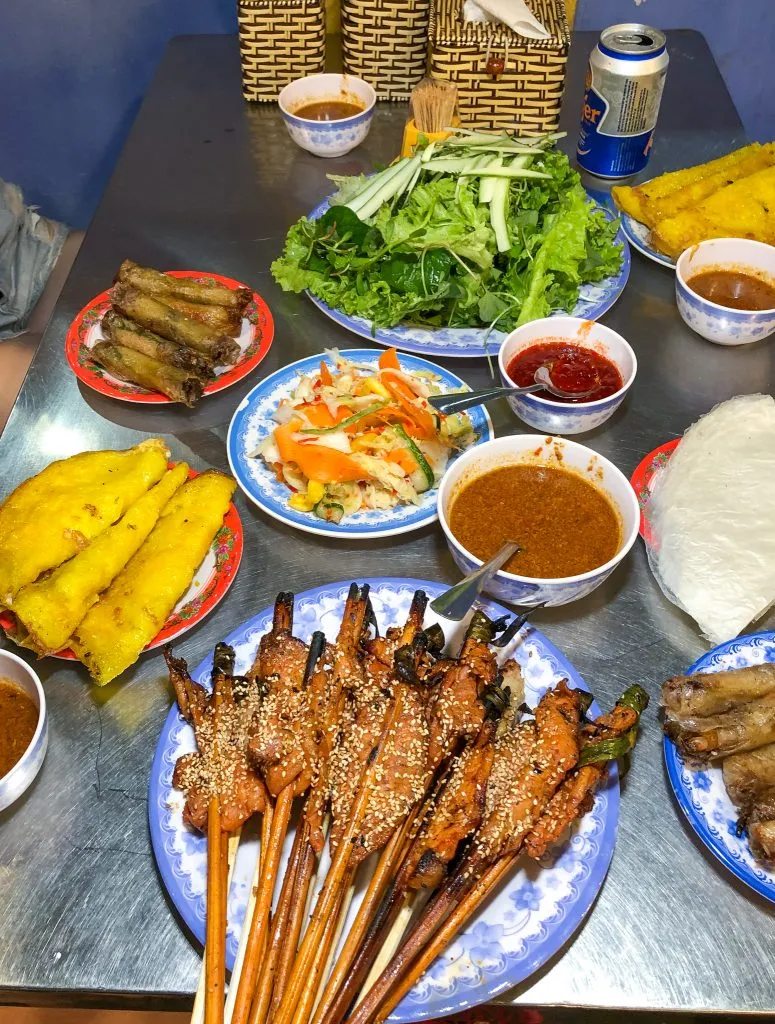 Spread of grilled meats, spring rolls, vegetables, and rice paper wrappers at Bale Well
Spread of grilled meats, spring rolls, vegetables, and rice paper wrappers at Bale Well
The fun lies in assembling your own bites: take a rice paper wrapper, add herbs, a piece of skewer, a spring roll, or a piece of Banh Xeo, roll it up, and dip it into the flavorful sauces. It’s a hands-on way to sample multiple items in one sitting and a fantastic value, ensuring you leave full and satisfied.
Beyond the Plate: Culinary Experiences in Hoi An
Exploring Hoi An Food Specialties isn’t limited to just eating individual dishes. The city offers a range of experiences that deepen your appreciation for its culinary culture and vibrant life.
Savoring Vietnamese Coffee: Khai Nguyen Coffee House
Vietnam is the world’s second-largest coffee producer, and its coffee culture is rich and distinct. Unlike the predominantly Arabica beans favored in the West, Vietnam largely cultivates Robusta, known for its higher caffeine content and bolder, sweeter profile. In Hoi An, enjoying a cup of Vietnamese coffee – whether traditional ca phe den (black coffee) or ca phe sua da (iced coffee with condensed milk) – is a quintessential experience.
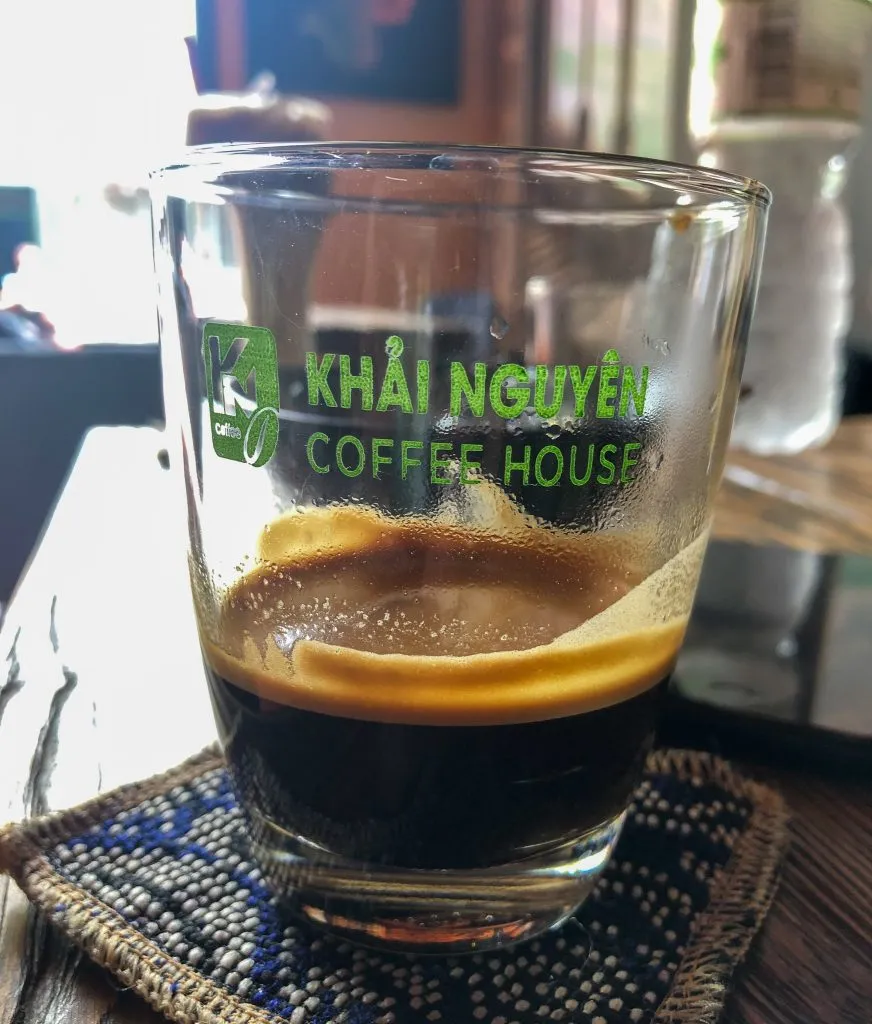 Interior view of a coffee shop with various coffee beans and equipment
Interior view of a coffee shop with various coffee beans and equipment
Places like Khai Nguyen Coffee House offer a chance to sample high-quality local beans prepared with care, providing a delightful pause between culinary explorations. Discovering Vietnamese coffee is a flavorful journey in itself and a perfect complement to the city’s food scene.
Vy’s Market: A Culinary Hub for Exploration
For those who want to sample a vast array of Hoi An Food Specialties and other Central Vietnamese dishes under one roof, Vy’s Market is an excellent (though tourist-oriented) option. Operated by Ms. Vy, who also owns the renowned Morning Glory restaurant, this venue functions like a large, upscale food hall.
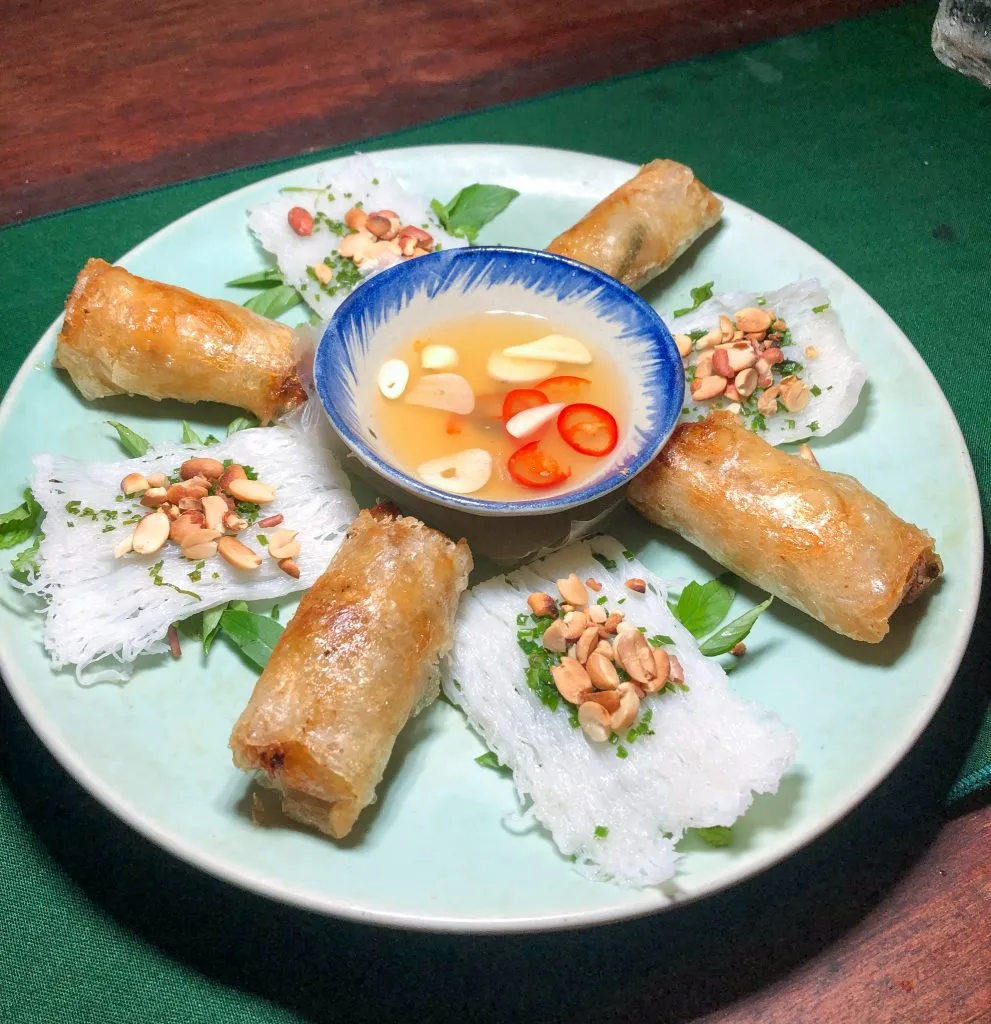 Buffet setup with various Vietnamese dishes at Vy’s Market
Buffet setup with various Vietnamese dishes at Vy’s Market
It presents an overwhelming selection of dishes prepared fresh at various stations, allowing you to see the cooking process. While individual dishes can be ordered, the “all you can eat” option is popular for groups or individuals keen to try small portions of many things. It’s a convenient way to experience the breadth of the region’s cuisine.
Diving Deeper: Cooking Classes and Food Tours
To truly understand Hoi An Food Specialties, consider taking a cooking class or joining a food tour. Many tours venture beyond the ancient town, introducing you to local markets, hidden eateries, and even offering immersive experiences like dining with a local family. Cooking classes provide hands-on learning about the ingredients and techniques behind favorite dishes like Banh Xeo or spring rolls. These activities offer valuable context, linking the food to the culture and people who create it.
 Group of people enjoying a meal outdoors as part of a food tour
Group of people enjoying a meal outdoors as part of a food tour
Such experiences go beyond just tasting; they build a deeper connection to the place and its traditions, providing insights that independent exploration might miss.
Planning Your Culinary Adventure
Exploring Hoi An Food Specialties is an adventure best approached with an open mind and an empty stomach. Don’t be afraid to try street food – many of the most authentic and delicious experiences happen at simple stalls. Balance your exploration between well-known spots and smaller, less famous eateries to get a broader perspective. Engage with the vendors, observe how the food is prepared, and savor each bite.
Hoi An’s food scene is dynamic and ever-evolving while staying true to its roots. Each dish offers a piece of the city’s history, culture, and daily life. Whether you’re a seasoned food traveler or new to Vietnamese cuisine, the Hoi An Food Specialties promise a journey that is as enriching as it is delicious.
Frequently Asked Questions (FAQ)
Q: Is Hoi An food spicy?
A: While Central Vietnamese cuisine is known for spice, many dishes in Hoi An are not inherently very spicy. The heat often comes from added chili sauces or fresh chilies you can control yourself, allowing you to adjust to your preference.
Q: Where can I find the best street food in Hoi An?
A: Excellent street food can be found throughout Hoi An, particularly just outside the ancient town area, around markets, and in small alleys. Don’t be afraid to look for stalls with locals queuing – that’s often a good sign.
Q: Are Hoi An Food Specialties safe to eat from street stalls?
A: Generally, yes. Look for stalls that appear clean, have a high turnover of customers (meaning fresh ingredients), and where food is cooked to order. Trust your instincts, but embrace the street food experience as it’s where many local favorites are found.
Q: What are the absolute must-try Hoi An Food Specialties?
A: If you have limited time, prioritize Cao Lau, Banh Mi (from a reputable spot like Phuong or Madam Khanh), White Rose dumplings, and Bale Well for a diverse tasting experience.
